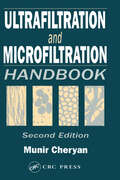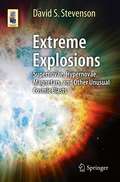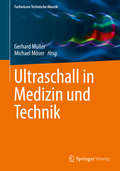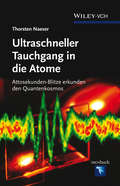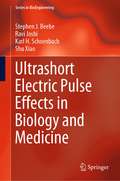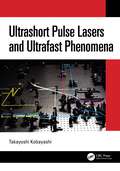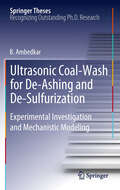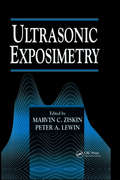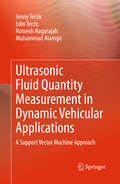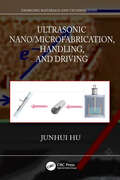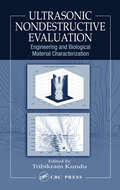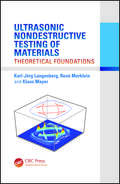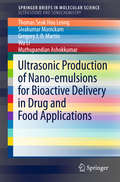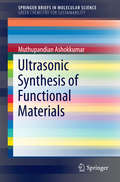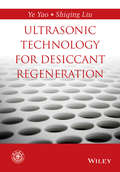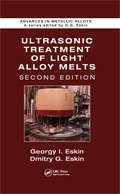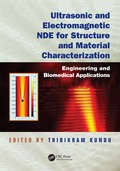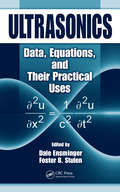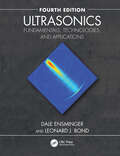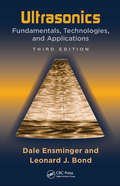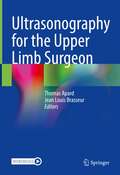- Table View
- List View
Ultrafiltration and Microfiltration Handbook
by Munir CheryanSoon after its publication in 1987, the first edition of Ultrafiltration Handbook became recognized as the leading handbook on ultrafiltration technology. Reviews in professional journals praised it as an authoritative and substantive information resource on this technology. Now a completely, updated and expanded edition is available under the titl
Ultrafine-Grained Materials (The Minerals, Metals & Materials Series)
by Terence G. Langdon Ruslan Z. Valiev Megumi Kawasaki Igor V. AlexandrovThis book summarizes and provides a detailed overview of the enhanced mechanical and functional properties of bulk nanostructured metallic materials with respect to their potential applications. These applications include nanostructured Ti-based materials in bio-medical engineering, Al alloys and Cu in electrical engineering and nanostructured steels in construction engineering. Moreover, this book describes the application of severe plastic deformation for the formation of hybrid metal systems from simple powders and solid metals for an enhancement in the functional properties of materials. Authored by global leaders in the field, this book will serve as a bridge between researchers and professionals engineering the newest nanomaterials.
Ultranovae!: Blasts from the Frontier of Astronomy
by David S. Stevenson'Supernovae!: Blasts from the Frontier of Astronomy' examines the most recent and exciting discoveries about what happens at the end of the stellar evolution of a massive stars. This book focuses on the extreme - the most intense and brilliant of astronomical explosions. It features the discoveries of SN 2007bi, a pair-instability supernova and SN 2006gy, a pulsational-pair instability supernova, or hypernova. These are highly significant observational finds that push the frontiers of astronomy and astrophysics, particularly as these objects were hitherto only predicted in theory and previously thought to be relics of the early universe, hence unobservable now. 'Supernovae!' examines and explains cataclysmic and unusual events at the very frontier of our knowledge of stellar astrophysics, and presents them in a way that non-professionals can understand and enjoy.
Ultraschall in Medizin und Technik (Fachwissen Technische Akustik)
by Michael Möser Gerhard MüllerDieser Band der Reihe Fachwissen Technische Akustik erläutert die technischen Grundlagen und Besonderheiten des Ultraschalls. Der Autor befasst sich mit der Erzeugung und Messung von Ultraschall und den Eigenschaften des Schallfeldes. In einem zweiten Teil werden einige wichtige Anwendungen von Ultraschall in Medizin und Technik dargestellt.
Ultraschneller Tauchgang in die Atome
by Thorsten NaeserDie Welt der Moleküle Atome und Elektronen strapaziert unsere Vorstellungskraft von Zeit. In Millionsteln einer milliardstel Sekunde finden chemische Reaktionen statt. Noch tausend Mal schneller, in Attosekunden, wechseln quantenmechanisch Elektronen ihren Aufenthaltsort in Atomen. Wer diese Elementarteilchen >fotografierenEr erzählt die Geschichte der Ultrakurzzeitphotographie, der Quantenmechanik und schließlich der auf modernster Lasertechnologie basierenden Attosekundenphysik. Schnell wird klar: Die Jagd nach immer kürzeren ?Belichtungszeiten?, noch winzigeren Sekundenbruchteilen und spektakulären Bildern aus dem Mikrokosmos ist in vollem Gang.
Ultrashort Electric Pulse Effects in Biology and Medicine (Series in BioEngineering)
by Stephen J. Beebe Ravi Joshi Karl H. Schoenbach Shu XiaoThis book presents an overview of the current state of research on ultrashort electric field pulses of high intensity and their use in biology and medicine. It examines in detail the most recent and exciting advances in how nanosecond and picosecond electric pulse research has grown and expanded into new areas of biology and medicine. Further, the book specifically focuses on electric pulses in the time domain, on intracellular effects as opposed to plasma membrane electroporation, and highlights the biological and medical applications of these unique pulse effects. Since the authors were initial innovators exploring nanosecond and picosecond pulses, their unique perspectives foreshadowed directions the research took, expanding into new areas that they continue to investigate today.
Ultrashort Pulse Lasers and Ultrafast Phenomena
by Takayoshi KobayashiThis book describes the basic physical principles of techniques to generate and ultrashort pulse lasers and applications to ultrafast spectroscopy of various materials covering chemical molecular compounds, solid-state materials, exotic novel materials including topological materials, biological molecules and bio- and synthetic polymers. It introduces non-linear optics which provides the basics of generation and measurement of pulses and application examples of ultrafast spectroscopy to solid state physics. Also it provide not only material properties but also material processing procedures. The book describes also details of the world shortest visible laser and DUV lasers developed by the author’s group. It is composed of the following 12 Sections: The special features of this book is that it is written by a single author with a few collaborators in a systematic way. Hence it provides a comprehensive and systematic description of the research field of ultrashort pulse lasers and ultrafast spectroscopy. Generation of ultrashort pulses in deep ultraviolet to near infrared Generation of ultrashort pulses in terahertz Carrier envelope phase (CEP) Simple NLO processes with a few colors Multi-color involved NLO processes Multi-color ultrashort pulse generation NLO materials NLO processes in time-resolved spectroscopy Low dimension materials Conductors and superconductors Chemical reactions and material processing Photobiological reactions
Ultrasonic Coal-Wash for De-Ashing and De-Sulfurization
by B. AmbedkarThis study focuses on the physical aspects of ultrasonic de-ashing and de-sulfurization, such as cavitation, streaming and their combined effects. Ambedkar Balraj proposes an ultrasound-assisted coal particle breakage mechanism and explores aqueous and solvent-based ultrasonic techniques for de-ashing and de-sulfurization. Ambedkar designs a Taguchi L-27 fractional-factorial matrix to assess the individual effects of key process variables. In this volume he also describes process optimization and scale-up strategies. The author provides a mechanism-based model for ultrasonic reagent-based coal de-sulfurization, proposes a flow diagram for ultrasonic methods of high-throughput coal-wash and discusses the benefits of ultrasonic coal-wash. Coal will continue to be a major fuel source for the foreseeable future and this study helps improve its use by minimising ash and sulfur impurities.
Ultrasonic Doppler Velocity Profiler for Fluid Flow
by Yasushi TakedaThe ultrasonic velocity profile (UVP) method, first developed in medical engineering, is now widely used in clinical settings. The fluid mechanical basis of UVP was established in investigations by the author and his colleagues with work demonstrating that UVP is a powerful new tool in experimental fluid mechanics. There are diverse examples, ranging from problems in fundamental fluid dynamics to applied problems in mechanical, chemical, nuclear, and environmental engineering. In all these problems, the methodological principle in fluid mechanics was converted from point measurements to spatio-temporal measurements along a line. This book is the first monograph on UVP that offers comprehensive information about the method, its principles, its practice, and applied examples, and which serves both current and new users. Current users can confirm that their application configurations are correct, which will help them to improve the configurations so as to make them more efficient and effective. New users will become familiar with the method, to design applications on a physically correct basis for performing measurements accurately. Additionally, the appendix provides necessary practical information, such as acoustic properties.
Ultrasonic Exposimetry
by Marvin C. Ziskin Peter A. LewinUltrasonic Exposimetry presents the fundamentals of ultrasonics and discusses the theoretical background of acoustic wave generation and reception. Measurements, instrumentation, and interpretation of measured data (including error analysis) are examined in detail.
Ultrasonic Fluid Quantity Measurement in Dynamic Vehicular Applications
by Edin Terzic Romesh Nagarajah Muhammad Alamgir Jenny TerzicAccurate fluid level measurement in dynamic environments can be assessed using a Support Vector Machine (SVM) approach. SVM is a supervised learning model that analyzes and recognizes patterns. It is a signal classification technique which has far greater accuracy than conventional signal averaging methods. Ultrasonic Fluid Quantity Measurement in Dynamic Vehicular Applications: A Support Vector Machine Approach describes the research and development of a fluid level measurement system for dynamic environments. The measurement system is based on a single ultrasonic sensor. A Support Vector Machines (SVM) based signal characterization and processing system has been developed to compensate for the effects of slosh and temperature variation in fluid level measurement systems used in dynamic environments including automotive applications. It has been demonstrated that a simple ν-SVM model with Radial Basis Function (RBF) Kernel with the inclusion of a Moving Median filter could be used to achieve the high levels of accuracy required for fluid level measurement in dynamic environments. Aimed toward graduate and postgraduate students, researchers, and engineers studying applications of artificial intelligence, readers will learn about a measurement system that is based on a single ultrasonic sensor which can achieve the high levels of accuracy required for fluid level measurement in dynamic environments.
Ultrasonic Guided Waves in Solid Media
by Joseph L. RoseUltrasonic guided waves in solid media have become a critically important subject in nondestructive testing and structural health monitoring, as new faster, more sensitive, and more economical ways of looking at materials and structures have become possible. This book will lead to fresh creative ideas for use in new inspection procedures. Although the mathematics is sometimes sophisticated, the book can also be read by managers without detailed understanding of the concepts as it can be read from a 'black box' point of view. Overall, the material presented on wave mechanics - in particular, guided wave mechanics - establishes a framework for the creative data collection and signal processing needed to solve many problems using ultrasonic nondestructive evaluation and structural health monitoring. The book can be used as a reference in ultrasonic nondestructive evaluation by professionals and as a textbook for seniors and graduate students. This work extends the coverage of Rose's earlier book Ultrasonic Waves in Solid Media.
Ultrasonic Nano/Microfabrication, Handling, and Driving (Emerging Materials and Technologies)
by Junhui HuUltrasonic nano/microfabrication, handling and driving is an emerging actuation technology, which utilizes ultrasonic vibration and the physical effects of ultrasonic vibration in fluids and solids to implement the fabrication, handling and driving of nano/micro scale objects. This book provides readers with the fundamentals, principles and characteristics of the ultrasonic devices for nano/micro fabrication, handling and driving, and design methods of the devices. • Introduces fundamental concepts and offers examples of ultrasonic nano fabrication, including ultrasonic nano rolling, cutting and coating methods. • Features a wealth of examples to illustrate the ultrasonic concentration and ultrasonic tweezers. • Explains the principles of ultrasonic driving of gas molecules and demonstrates their applications in high-performance gas sensor systems and metal-air flow batteries. • Teaches the principles of ultrasonic driving of microfluids and their applications in metal-air flow batteries and cooling of small solid heat sources. • Provides examples for the finite element method (FEM) modeling and computation of ultrasonic devices for nano/micro fabrication, handling and driving. • Summarizes the current and future trends in ultrasonic nano/microfabrication, handling, and driving. This book shares the advances, methods and applications of ultrasonic micro/nano fabrication techniques for entry-level and advanced readers working on nano/microfabrication, gas sensing, biological sensing, metal-air batteries, electronic component cooling, and other related areas.
Ultrasonic Nondestructive Evaluation: Engineering and Biological Material Characterization
by Tribikram KunduMost books on ultrasonic nondestructive evaluation (NDE) focus either on its theoretical background or on advanced applications. Furthermore, information on the most current applications, such as guided wave techniques and acoustic microscopy, is scattered throughout various conference proceedings and journals. No one book has integrated these aspe
Ultrasonic Nondestructive Testing of Materials: Theoretical Foundations
by Klaus Mayer Karl-Jörg Langenberg René MarkleinUltrasonic Nondestructive Testing of Materials: Theoretical Foundations explores the mathematical foundations and emerging applications of this testing process, which is based on elastic wave propagation in isotropic and anisotropic solids. In covering ultrasonic nondestructive testing methods, the book emphasizes the engineering point of view, yet
Ultrasonic Production of Nano-emulsions for Bioactive Delivery in Drug and Food Applications (Springerbriefs In Molecular Science: Chemistry of Foods)
by Muthupandian Ashokkumar Sivakumar Manickam Wu Li Thomas Seak Leong Gregory J. MartinThis SpringerBrief provides an overview of ultrasonic emulsification and an update on recent advances in developing stable emulsions for the creation of novel drugs and functional foods, with a focus on bioactive delivery in these products.Emulsification is the process of combining two or more immiscible liquids to form a semi-stable mixture. These two liquids generally consist of an organic (oil) phase and an aqueous (water) phase that is stabilized by the addition of an emulsifier. Most common emulsions are of the oil-in-water (O/W) type, but can also be of water-in-oil (W/O) or even multiple emulsion types (i.e. double emulsions) in the form of water-in-oil-in-water (W/O/W) or oil-in-water-in-oil (O/W/O) phases. The formation of an emulsion requires input of energy to distribute the disperse phase in the continuous phase in small-sized droplets that are able to resist instability. There is great interest in the use of ultrasound to produce emulsions, as it is able to do so relatively efficiently and effectively compared to existing techniques such as rotor stator, high-pressure homogenization and microfluidization. The interaction of ultrasound with the hydrocolloids and biopolymers that are often used to stabilize emulsions can offer advantages such as improved stability or greater control of formed droplet size distributions.
Ultrasonic Spectroscopy: Applications in Condensed Matter Physics and Materials Science
by Robert G. LeisureUltrasonic spectroscopy is a technique widely used in solid-state physics, materials science, and geology that utilizes acoustic waves to determine fundamental physical properties of materials, such as their elasticity and mechanical energy dissipation. This book provides complete coverage of the main issues relevant to the design, analysis, and interpretation of ultrasonic experiments. Topics including elasticity, acoustic waves in solids, ultrasonic loss, and the relation of elastic constants to thermodynamic potentials are covered in depth. Modern techniques and experimental methods including resonant ultrasound spectroscopy, digital pulse-echo, and picosecond ultrasound are also introduced and reviewed. This self-contained book includes extensive background theory and is accessible to students new to the field of ultrasonic spectroscopy, as well as to graduate students and researchers in physics, engineering, materials science, and geophysics.
Ultrasonic Synthesis of Functional Materials
by Muthupandian AshokkumarThis book begins by giving a summary of sonochemistryand explains how a chemical reaction can be induced by the interaction of soundwaves and gas bubbles in liquids. The work outlines how primary and secondaryradicals combined with the physical effects generated during acousticcavitation are active in the ultrasonic synthesis of a variety of functionalmaterials. The brief covers hot topics that include ultrasonic synthesis ofvarious functional materials covering the following broad areas: acoustic cavitationand sonochemistry, synthesis of functional polymers and their applications, synthesisof functional inorganic materials and their applications, improving functionality of food/dairy systems, synthesis of functionalbiomaterials and their applications, synthesis of graphene based catalytic materials. Theory is kept to a minimum. The book is aimed at individuals at universitiesand will also interest those in industry. It is suitable for all levels.
Ultrasonic Technology for Desiccant Regeneration
by Shiqing Liu Ye YaoThe chapters in this volume explore ultrasound-assisted regeneration of silica gel, ultrasound-assisted regeneration for a new honeycomb desiccant material, ultrasound-atomizing regeneration for liquid desiccants, ultrasonic transducers, and much more.
Ultrasonic Treatment of Light Alloy Melts (Advances in Metallic Alloys)
by Dmitry G. Eskin Georgy I. EskinSpawned by growing interest in ultrasonic technology and new developments in ultrasonic melt processing, the Second Edition of Ultrasonic Treatment of Light Alloy Melts discusses use of ultrasonic melt treatment in direct-chill casting, shape casting, rapid solidification, zone refining, and more, exploring the effects of power ultrasound on melt d
Ultrasonic and Electromagnetic NDE for Structure and Material Characterization: Engineering and Biomedical Applications
by Tribikram KunduMost books on nondestructive evaluation (NDE) focus either on the theoretical background or on advanced applications. Bridging the gap between the two, Ultrasonic and Electromagnetic NDE for Structure and Material Characterization: Engineering and Biomedical Applications brings together the principles, equations, and applications of ultrasonic and
Ultrasonics: Data, Equations and Their Practical Uses
by Dale Ensminger Foster B. StulenGain a Unique and Comprehensive Understanding of UltrasonicsDespite its importance, most books on ultrasonics cover only very specific sub-fields of the science. They generally also take a more mathematical approach and lack the wider scope needed to truly improve understanding and facilitate practical use of ultrasonics across a wide range of disc
Ultrasonics: Fundamentals, Technologies, and Applications (Mechanical Engineering Ser.)
by Dale Ensminger Leonard J. BondUpdated, revised, and restructured to reflect the latest advances in science and applications, the fourth edition of this best-selling industry and research reference covers the fundamental physical acoustics of ultrasonics and transducers, with a focus on piezoelectric and magnetostrictive modalities. It then discusses the full breadth of ultrasonics applications involving low power (sensing) and high power (processing) for research, industrial, and medical use. This book includes new content covering computer modeling used for acoustic and elastic wave phenomena, including scattering, mode conversion, transmission through layered media, Rayleigh and Lamb waves and flexural plates, modern horn design tools, Langevin transducers, and material characterization. There is more attention on process monitoring and advanced nondestructive testing and evaluation (NDT/NDE), including phased array ultrasound (PAUT), long-range inspection, using guided ultrasonic waves (GUW), internally rotary inspection systems (IRIS), time-of-flight diffraction (TOFD), and acoustic emission (AE). These methods are discussed and applied to both metals and nonmetals using illustrations in various industries, including now additionally for food and beverage products. The topics of defect sizing, capabilities, and limitations, including the probability of detection (POD), are introduced. Three chapters provide a new treatment of high-power ultrasonics, for both fluids and solids, and again, with examples of industrial engineering, food and beverage, pharmaceuticals, petrochemicals, and other process applications. Expanded coverage is given to medical and biological applications, covering diagnostics, therapy, and, at the highest powers, surgery.Key Features Provides an overview of fundamental analysis and transducer technologies needed to design and develop both measurement and processing systems Considers applications in material characterization and metrology Covers ultrasonic nondestructive testing and evaluation and high-power ultrasonics, which involves interactions that change the state of material Highlights medical and biomedical applications of ultrasound, focusing on the physical acoustics and the technology employed for diagnosis, therapy, surgery, and research This book is intended for both the undergraduate and graduate scientists and engineers, as well as the working professional, who seeks to understand the fundamentals together with a holistic treatment of the field of ultrasonics and its diversity of applications.
Ultrasonics: Fundamentals, Technologies, and Applications, Third Edition
by Dale Ensminger Leonard J. BondThe book provides a unique and comprehensive treatment of the science, technology, and applications for industrial and medical ultrasonics, including low- and high-power implementations. The discussion of applications is combined with the fundamental physics, the reporting of the sensors/transducers, and systems for the full spectrum of industrial, nondestructive testing, and medical/bio-medical uses. It includes citations of numerous references and covers both mainstream and the more unusual and obscure applications of ultrasound.
Ultrasonography for the Upper Limb Surgeon
by Thomas Apard Jean Louis BrasseurThis book combines orthopedists’ and radiologists’ perspectives to provide a comprehensive overview of the rapidly expanding use of ultrasound in orthopedic surgery. It also highlights the growing awareness of the potential of this non-invasive and portable, real-time imaging tool, which has led to its inclusion in the minimally invasive toolkit of upper limb surgeons.The book is divided into five parts – shoulder, elbow, forearm, hand and wrist and fingers. Each part focuses on a particular anatomic region or joint, carefully analyzing the sonoanatomy of its nerves, tendons and bones. For each region, experienced experts illustrate how to perform specific techniques under ultrasound control, ranging from classic procedures, like carpal tunnel release, to the treatment of less common conditions. Covering all the basic and practical aspects of this innovative, multi-disciplinary approach, as well as future perspectives, this unique book is a must-read for all orthopedists, radiologists, sports physicians and physiotherapist wanting to gain insights into this promising field.
